In 70% of adults, the neck is injured at different intervals. In this case, pain can not only have different properties, but can also be caused by a variety of diseases. Therefore, they are not mainly observed in isolation, but accompanied by other symptoms, which help to correctly diagnose and choose the best treatment strategy.
Types of neck pain

Neck pain can be short-term, limited to mild discomfort, or it can be very severe, which seriously interferes with daily life. People complain more that they feel back pain suddenly, and then continue to experience pain. It can be pain, tingling, movement, contraction or other forms.
Neck pain is also called neck pain.
Generally, during movement (for example, when rotating or tilting the head), especially when using the computer for a long time, the discomfort will increase while maintaining a static (especially uncomfortable) static position. In this regard, a person is often forced to turn his entire body even unconsciously to save his neck as much as possible.
Therefore, it is obvious that neck pain can be very different. Therefore, they are not only divided into acute (less than 10 days in duration) and chronic, but also divided into:
- is vertebral-occurs in the context of pathological changes in the cervical spine, including disc disease, spinal cord root and spinal cord compression;
- Non-vertebral-caused by all other causes, including infectious diseases, inflammatory processes in the muscles, thyroid disease, lymphadenitis, etc.
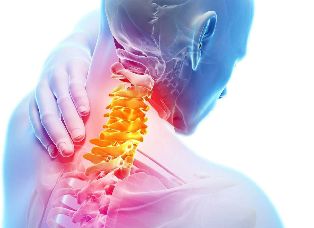
Vertebral origin pain is characterized by exposure to the occipital region, shoulders, arms, hands and fingers. Usually, numbness, impaired sensitivity and mobility are observed, which indicates the development of neurological diseases, that is, violation of one or another anatomical structure of the nerve root or spinal cord. Also, in this case, dizziness, loss of consciousness and headaches can be observed, which indicates that the vertebral artery is compressed, such as an intervertebral hernia.
If you have severe neck pain or dizziness, numbness behind the head, or tinnitus, you need to make an appointment with your doctor.
Causes of neck pain
Sometimes, it is difficult for patients to distinguish between sore throat and neck pain independently because it spreads so badly, it feels fuzzy, and it seems that the entire neck hurts. If this is accompanied by a sensation of sweating or scratching in the throat, and an increase in body temperature, it may indicate laryngitis, acute respiratory viral infection, sore throat, pharyngitis and other colds. Again, this symptom usually applies to:
- Gastroesophageal reflux;
- Itsenko-Cushing syndrome;
- Foreign objects enter the pharynx, such as fish bones;
- Vitamin deficiency;
- Formation of benign and malignant tumors in the throat.
Still, in most cases, people can distinguish throat problems from real neck pain, which can be seen on the anterior lateral surface as well as the front and back sides.
The location of pain is an important diagnostic function that allows you to determine the source of pain during the examination phase, and then thoroughly study the changes that occur in the diagnostic method using the instrument.
Anterior neck pain: causes
Discomfort and even pain in the area directly under the chin, or spreading pain throughout the front of the neck, may indicate:
- Thyroid disease;
- The inflammatory process in muscles affects ligaments and nerves;
- Formation of cysts and abscesses; The influence of lymph nodes;
- Angina.

In other words, the list of possible causes is very extensive, and it is impossible to independently determine what caused the neck pain. In this case, it is worth contacting a therapist for examination. If necessary, the doctor will refer the patient to a stricture specialist with the required characteristics.
Vertebral artery syndrome and nerve syndrome may also be related to anterior neck pain. In both cases, the cause is deformed intervertebral discs, edema, displaced cervical vertebrae or other structures that invade blood vessels or nerves. Our clinic has developed a comprehensive method to solve this problem-experienced chiropractors, neurologists, rehabilitation specialists, endocrinologists will conduct examinations and prescribe necessary treatments.Back and neck pain: causes
Due to the peculiarities of modern lifestyles, people often worry about pain in the back of the neck. Working on a computer, constant use of gadgets, low-level physical exercises and bad habits, all of which can lead to pathological changes in the structure of the spine, manifested as neck pain. Therefore, if there is soreness, traction, severe pain, back neck and back pain, first of all, you need to consult a chiropractor or vertebral surgeon, because in most cases, this indicates cervical spondylosis, namely:
- Herniation-a complication of osteochondrosis, in which the intervertebral disc herniated (more into the spinal canal, the spinal cord and nerve roots pass through), which has the risk of pinching nerves and vertebral arteries;
- Intervertebral disc herniation is the result of lack of treatment, in which the internal content of the intervertebral disc penetrates into the spinal canal, gradually increasing and will severely compress the nerves and spinal cord. In the final stage of development, it separates and "walks" along the spinal canal, Leading to serious and sometimes irreversible complications until paralysis;
- Spinal disease is a complication of osteochondrosis, in which bony protrusions called osteophytes grow along the edges of the vertebral body, and the intervertebral discs are severely compressed, eventually causing adjacent vertebrae to fuse with each other and restrict neck movementSex;
- Myofascial syndrome-a disease of individual muscle spasms that can cause acute pain attacks during physical exercise or when pressing certain parts of the neck;
- Vertebral compression fractures-most commonly occurring in elderly people with osteoporosis, or caused by whipping injuries (such as in accidents), posing a serious threat to human life and health;
- Ankylosing spondylitis is a systemic disease that affects almost all joints of the body, and due to the fusion of various vertebrae, the mobility is severely restricted, forming a strong and immovable mass.
Spine tuberculosis, osteomyelitis or Reiter’s syndrome caused back neck pain are rarer.
Side neck pain: the cause
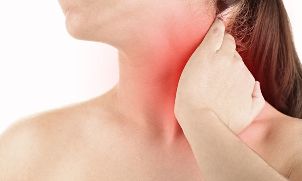
In most cases, the pain on the side of the neck is burning or throbbing, or it may sting. They tend to succumb to the shoulders and ears, sometimes accompanied by the formation of secondary torticollis, as a result of which the head tilts towards the affected side. This is usually used:
- Vascular diseases, including atherosclerosis;
- Muscle cramps, which may be caused by strong neck load, sudden movement or hypothermia;
- Malignant tumors are formed in the thyroid, pharynx and larynx.
Diagnose the cause of neck pain
Because in the vast majority of cases, neck pain is caused by the pathological development of the cervical spine, it is worth contacting a chiropractor, orthopedist or neurologist when they appear. The doctor will be able to determine whether the neck discomfort is actually caused by spinal disease or other diseases based on the chief complaint, examination data and neurological examination.
However, in fact, this is the reason why the state of the spine deviates from the normal state, and it is one of the reasons that cause the development of internal organs with diseases. After all, changes in the position of the vertebrae, reduction in the height of the intervertebral discs, and other even small changes result in violation of the transmission of nerve impulses from the spinal cord through the nerve roots along the nerves to the internal organs.
Since the spinal cord is characterized by segmental innervation, that is, each part of it is responsible for the correct function of specific organs. If cervical disease occurs, the innervation of the ENT organ, vocal cords, thyroid and parathyroid glands will beThe muscles of the neck, shoulders and forearms are affected. Therefore, at first, their work was disrupted, and over time, organic changes occurred, that is, the development of one kind or another of diseases may cause pain of different strength and personality in the neck.
Therefore, visceral diseases are rarely diagnosed and no changes in the spine are detected. Therefore, it is necessary to consult a chiropractor without difficulty. However, if patients have signs of thyroid, heart, ENT organs or other diseases, they can also get advice from stenosis specialists (endocrinologists, cardiologists, otolaryngologists, etc. ).
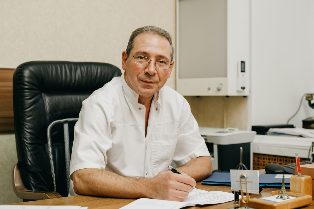
Therefore, the diagnosis of the cause of neck pain is always complicated. It can include:
- Routine and biochemical blood tests;
- Measure the level of thyroid hormone in the blood;
- Ultrasound examination of the blood vessels in the neck, thyroid and salivary glands;
- X-ray of the cervical spine;
- Electromyography;
- CT;
- MRI.
In order to diagnose the pathology of the spine, the most useful is MRI, that is, magnetic resonance imaging. This method allows you to study the state of the intervertebral disc with the smallest details, assess the blood flow quality of the vertebral artery, and detect signs of compression of the spinal cord or its roots. With its help, the disease can be diagnosed at the earliest stage of its development, thus ensuring that treatment is started as soon as possible and its efficiency is improved.
In our clinic, you can also learn more about body composition and the state of the vascular system, which involves the blood supply to internal organs, musculoskeletal muscles and the brain. . Our experienced doctor will explain these findings to you in detail. The bioimpedance measurement method calculates the ratio of fat, muscle, bone and bone mass, total fluid, and basal metabolic rate. The recommended physical exercise intensity depends on the muscle condition. The metabolic process in turn affects the body's ability to recover. According to the index of active cell mass, the level of physical activity and nutritional balance can be judged. This simple and quick test helps us find endocrine disorders and take measures. In addition, for us, understanding the condition of blood vessels is also very important for preventing heart disease, high blood pressure, heart failure, diabetes and other diseases. Angioscan allows you to determine important indicators such as the biological age of blood vessels, its stiffness, pressure index (representing heart rate), and blood oxygen saturation. This screening is useful for men and women under 30, athletes, people who have suffered long-term and arduous treatment, and everyone who monitors their health.
In this case, the analysis of body composition provides us with information that the body is dominated by fat tissue, while the bone-muscle composition is relatively insufficient. These data will help the recovering person to make a correct physical exercise plan according to the patient's personal characteristics.
Neck pain treatment
For each patient, a treatment strategy will be strictly formulated based on the diagnosis, the severity of pathological changes, the existence of accompanying diseases and other factors. Even patients with the same disability can receive different treatments, because even age and physical development level will affect them.
However, the treatment of diseases that cause neck pain is always complicated, including symptomatic treatment and psychiatric treatment. In other words, its purpose is to eliminate the symptoms of the disease and its causes. The main components of treatment are usually:
- medication;
- Bone disease;
- Manual therapy;
- Massage;
- Physical therapy (speech therapy, carboxyl therapy, ozone therapy, compression therapy radiofrequency current);
- Individual courses with rehabilitation doctors.

When diagnosing cervical spondylosis, it will change your lifestyle and habits. Therefore, it is recommended that office workers, drivers, tailors and other sedentary professionals should warm up as much as possible and avoid long-term forced postures, especially when the neck muscles need to be stretched.
The right diet is also very important so that the body gets all the nutrients it needs. This will not only slow down the pathology process, but also help speed up the regeneration process.
If the pain is severe, the chiropractor may recommend the patient to buy a neck brace or Chance collar. Wearing it helps to reduce the burden on the cervical spine, avoid rashes, and move suddenly, which will cause the pain syndrome to gradually disappear. In our center, you can choose and buy bandages that suit you.
You can wrap your neck with a woolen scarf to relieve pain before the date, or take anesthetics within 12 hours before taking it.
Medications
The nature and quantity of prescription drugs can vary within a wide range, depending directly on the diagnosis and the presence of accompanying diseases. Therefore, we only list those drugs prescribed for most patients:
- NSAIDs are non-steroidal anti-inflammatory drugs with different analgesic properties (produced in various dosage forms, including tablets, ointments, injections, etc. );
- Corticosteroids are drugs with powerful anti-inflammatory effects and are only used for severe inflammatory processes that cannot be eliminated by NSAIDs.
- Muscle relaxants-drugs that eliminate various causes of muscle cramps and help reduce the severity of pain;
- Cartilage protective agent-a drug that promotes the recovery of the cartilage tissue that makes up the intervertebral disc, but it is only effective in the initial stage of osteochondrosis;
- B vitamins-used to improve the conduction of bioelectrical impulses from the spinal cord to the corresponding organs and restore their normal functions;
- Vitamin D-a drug that is responsible for the condition of bone tissue and advanced brain functions (such as memory, memory, attention, speech).
In addition, antibiotics, hormone replacement therapy, antihypertensive drugs and other drugs can be prescribed for patients.
For particularly severe neck pain, use an obstruction. The process involves injecting anesthetics and corticosteroids into the area where the nerves of the neck pass, which can relieve pain very quickly. However, besides that they are only effective for pain caused by nerve damage, a high degree of expertise of medical experts is also required, because there is a risk of nerve damage, infection and serious complications when the blockade is performed.
Manual therapy
Manual therapy is one of the most effective ways to deal with neck pain and its causes, but it must be done correctly. It directly affects the spine and surrounding soft tissues. Do not confuse manual therapy with therapeutic massage, which can only exercise the back and neck muscles.
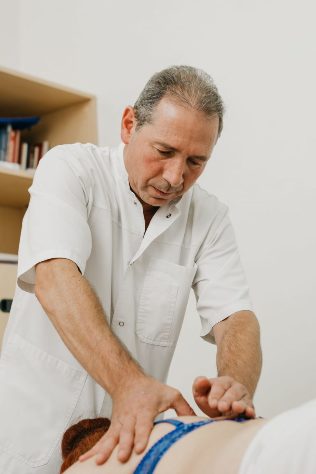
The technique and method of manual treatment can literally improve the health condition after the first session of treatment, and finally relieve completely. This can be achieved in the following ways:
- Restores the normal axis of the spine by returning the vertebrae to their anatomically correct positions.
- Increases the distance between the vertebrae and the release of compressed nerves and blood vessels, which helps to eliminate the signs of radiation nerve syndrome and improve the function of internal organs, especially the brain;
- Eliminate the spasm of neck muscles and functional blocks, thereby improving mobility and reducing the severity of pain;
- Improve blood circulation and tissue nutrition.
We do not have a universal treatment standard, so we use a separate method for each patient. Only highly qualified experts can perform manual treatment. Otherwise, using inappropriate technology will only harm the patient, exacerbate the problem or cause complications.
Physical Therapy
Physiotherapy procedures are used to improve the treatment effect. They are only used outside the acute phase, and have analgesic, anti-inflammatory effects, and improve the microcirculation in soft tissues, and help normalize muscle tension.
Generally, the prescribed curriculum includes 8-15 programs. These can be:
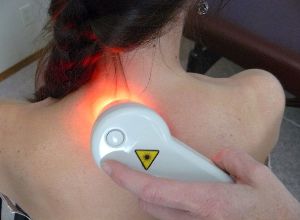
- Electrophoresis;
- UHF;
- Ultrasound therapy;
- Laser therapy;
- Traction therapy (spine traction);
- Mud bath etc.
The number of courses of physical therapy procedures and the frequency of their procedures are individually selected by the doctor. Some processes can be combined with each other, while other processes should be executed strictly at certain intervals.
Exercise therapy
Physiotherapy is one of the essential ingredients for conservative treatment of neck pain. Since they usually occur in the context of muscle overwork and the resulting process of degenerative disc dystrophy, it is important to pay attention to exercise therapy and exercise every day.
For each patient, the rehabilitation physician will formulate a physical therapy practice program. Using the complexes that exist on the Internet can be dangerous because they do not take into account the patient's personal characteristics, the patient's age, the degree of neglect of the pathological process, and the patient's physical fitness. Therefore, to develop an exercise therapy plan, you need expert help. In addition, the first few lessons must be conducted under his control, so that the patient can understand how to perform each exercise without harming themselves during the independent learning process. At home, you should practice in a relaxed atmosphere, avoid sudden movements, and see a doctor if you experience pain.
Therefore, neck pain is very common. They may be caused by the development of various diseases, but the most common discomfort is spinal problems caused by a sedentary lifestyle. Therefore, you should go to the doctor without hesitation. Indeed, in the early stages of disease development, it can be easily resolved with conservative methods. In advanced cases, only surgery can eliminate neck pain and its causes.

























